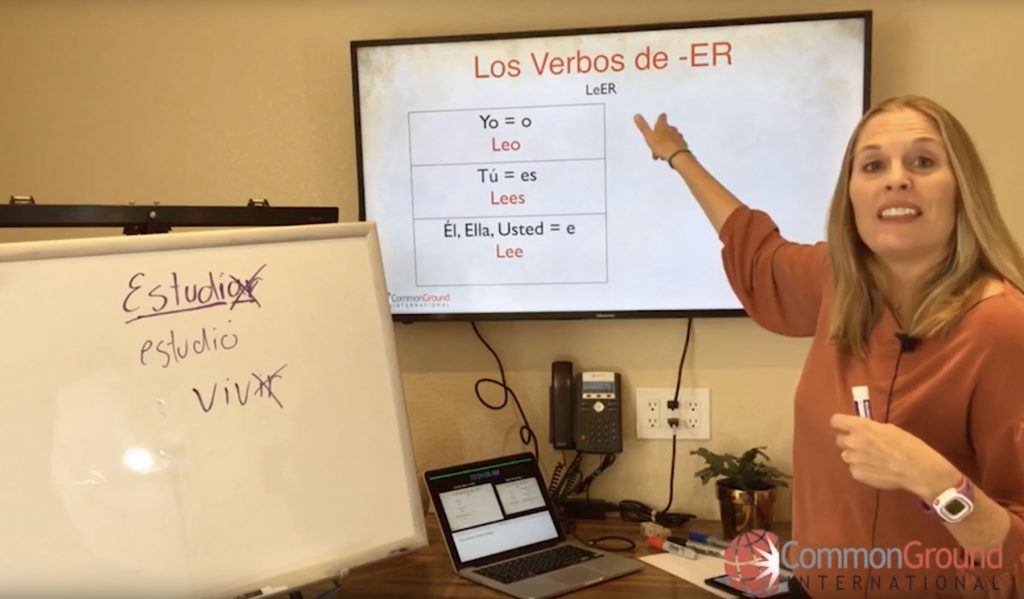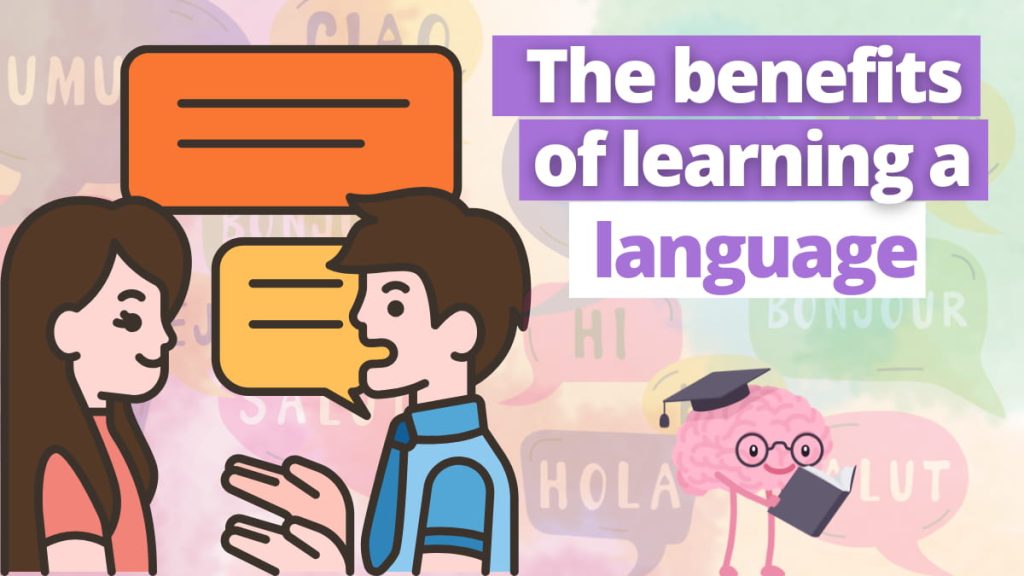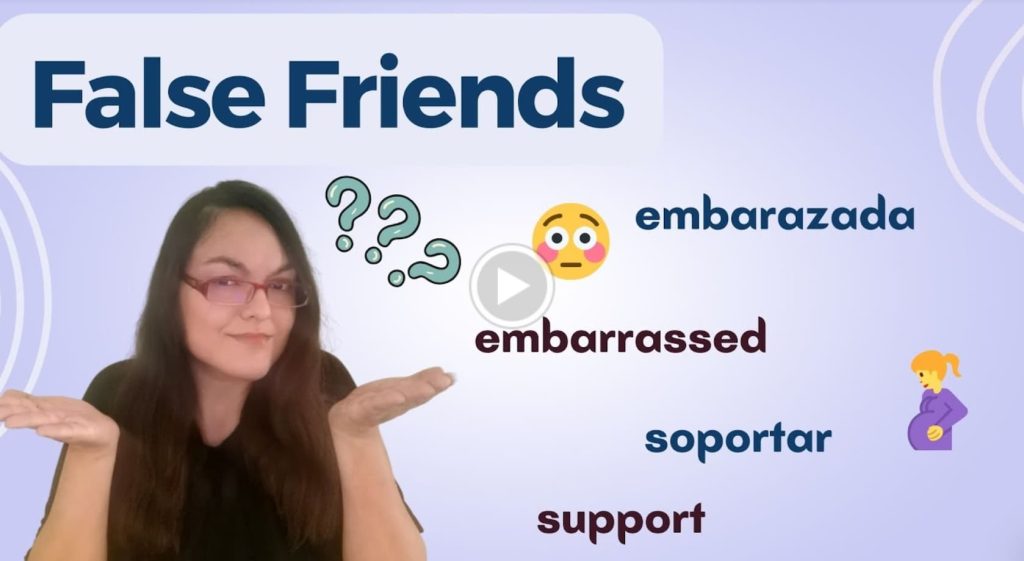Present Tense Verb Refresher! In this Spanish for Educators lesson you will learn how to use and conjugate the regular verbs in the present in Spanish: Verbos regulares en el presente
Su reto profesional: Empieza a usar los verbos regulares en el presente en español con tus estudiantes o sus padres/tutores. Start using these verbs in your class and/or create your own sentences using them 🙂
Here is the Spanish lesson I taught to my Maestro Miércoles Facebook group:
Subscribe to our YouTube Channel to see all of our lessons and get the latest videos right away!
El objetivo de esta lección / Lesson Objective
En esta lección, teachers will:
- Learn how to conjugate regular verbs in the present tense
- Understand that there is a conjugation pattern to memorize
- From complete sentences in the present tense
- Start communicating with correct regular present tense verb conjugations!
Since this is an extensive lesson, I’m adding a menu so you can click on any of the items to check that specific part of the lesson:
- Some Examples of Regular Verbs in the Present Tense
- Pronouns in Spanish
- Regular / Irregular Verbs
- Steps to Start Conjugating Verbs in Spanish
- -AR Verbs Conjugation
- -ER Verbs Conjugation
- -IR Verbs Conjugation
- Let’s Practice
- Key Verbs in the Classroom
Unos ejemplos / Some Examples
Let’s start the lesson with some examples of regular verbs in the present tense. Do you see any patterns?
Los Pronombres en Español / Pronouns in Spanish
Let’s repasar the subject pronouns in Spanish! It is important for you to know all of them because they determine how you conjugate the verb.
| Spanish | English |
| Yo | I |
| Tú | You – informal / familiar |
| Él, Ella, Usted | He, she, you – formal / unfamiliar |
| Nosotros / Nosotras |
We |
| Vosotros / Vosotras | You all (España) |
| Ellos, Ellas, Ustedes | They, you all |
Verbos Regulares / Irregulares: When we talk about present tense verbs. There are 4 big categories to learn:
| Spanish | English |
| 1. Verbos regulares | 1. Regular Verbs |
| Hablar, escribir, estudiar | Talk, write, study |
| 2. Verbos irregulares | 2. Irregular Verbs |
| Ir, hacer, tener | Go, do/make, have |
| 3. Verbos con Cambio de Raíz | 3. Stem-Changing Verbs |
| Poder, dormir, revolver | Be able to, sleep, stir |
| 4. Verbos reflexivos | 4. Reflexive verbs |
| Despertar(se), levantar(se), sentar(se) | Awake, raise, sit |
Clasificaciones de Verbos / Verbs Classification: Verbs unconjugated or in the infinitive either end in -AR, -ER, -IR.
You need to know how verbs end so you know how to conjugate them.
¿Qué es un infinitivo? / What is an infinitive?
Un verbo en el infinitivo no está conjugado. It is un-conjugated verb.
Unos ejemplos: Verbo + Infinitivo
An already conjugated verb followed by an infinitive.
| AR | ER | IR |
| Hablar | Leer | Escribir |
| Determinar | Hacer | Compartir |
| Identificar | Ver | Describir |
| Analizar | Poder | Predecir |
| Imaginar | Tener | Evaluar |
To start conjugating verbs in present tense in Spanish, you need to follow two simple steps:
El primer paso / First Step
1. Quitar la terminación de -AR, -ER. -IR / Remove the -AR, -ER, -IR Ending
| Verbos -ar: | Verbos -er: | Verbos -ir: |
| Examinar – Examin_ | Comer | Escribir – Escrib_ |
| Estudiar | Leer – Le_ | Vivir |
El segundo paso / Second Step
2. Agregar la terminación del presente / Add the Present Tense Ending
-AR
| Yo = O | Nosotros = AMOS |
| Tú = AS | |
| Él, Ella, Usted = A | Ellos, Ellas, Ustedes = AN |
-ER
| Yo = O | Nosotros = EMOS |
| Tú = ES | |
| Él, Ella, Usted = E | Ellos, Ellas, Ustedes = N |
-IR
| Yo = O | Nosotros = IMOS |
| Tú = ES | |
| Él, Ella, Usted = E | Ellos, Ellas, Ustedes = N |
Los verbos del -AR / -AR Verbs
EstudiAR (To Study)
|
Yo = o Estudio |
Nosotros/as = amos Estudiamos |
|
Tú = as Estudias |
Vosotros/as = áis Estudiáis |
|
Él, Ella, Usted = a Estudia |
Ellos, Ellas, Ustedes = an Estudian |
Los verbos del -ER
LeER (To Read)
|
Yo = o Leo |
Nosotros/as = emos Leemos |
|
Tú = es Lees |
Vosotros/as = éis Leéis |
|
Él, Ella, Usted = e Lee |
Ellos, Ellas, Ustedes = emos Leemos |
Los verbos del -IR
EscribIR (To Write)
|
Yo = o Escribo |
Nosotros/as = imos Escribimos |
|
Tú = es Escribes |
Vosotros/as = ís Escribís |
|
Él, Ella, Usted = e Escribe |
Ellos, Ellas, Ustedes = en Escriben |
Vamos a practicar / Let’s Practice
Finally, ¡Vamos a practicar un poquito! Let’s practice a little bit 🙂
| Spanish | English |
| 1. La maestra __________ (trabajar) en la escuela bilingüe. | The teacher works in a bilingual school |
| 2. Nosotros __________ (estudiar) español. | We study Spanish |
| 3. Tú __________ (comer) muchas frutas y verduras. | You eat a lot of fruits and vegetables |
| 4. Yo __________ (vivir) en Colorado. | I live in Colorado |
| 5. Él __________ (escribir) un ensayo. | He writes an essay |
Note: Share your answers or your own sentences on our Facebook group for correction from other Spanish learners!
Verbos Claves del Salón de Clase
Since there are MANY verbs in Spanish to learn from now on, I decided to share with you a short list of verbs that are useful in the classroom, so you can start talking to your students using these common verbs in a very short time 🙂
Now it’s your turn! / Ahora es tu turno
Download the lesson notes and start creating your own sentences using this new vocabulary in Spanish and share them on the comments below or in our Facebook group to receive feedback from other Spanish learners
See the following examples:
1. Escribir textos (yo)
• Escribo
2. Sustentar (sustain) las ideas con razones y ejemplos organizados (tú)
• Sustentas
3. Lograr (achieve) cohesión y coherencia (él)
• Logra
4. Usar estrategias y procesos de pensamiento (ellos)
• Usan
5. Apoyar (support) la escritura de diferentes tipos de textos, ejemplos (nosotros)
• Apoyamos





